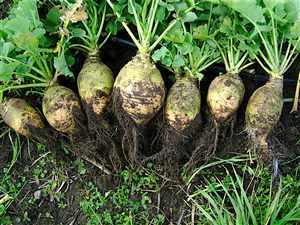Rutabaga (Brassica napobrassica), Swedish turnip
Main Facts about Rutabaga

Using Rutabaga
Rutabagas are rich in fiber, pectin and sugars, contain more vitamin A than turnips. They don’t contain any starch and cholesterol. Rutabaga is rich in vitamin C which aid to lessen wheezing in asthma patients and is also good for nails, skin, and hair. Due to the high content of fibre, rutabaga helps control blood cholesterol levels and is said to be effective in combating constipation. However, it may cause gas. It is also good for digestion and for increasing stamina. It is rich in potassium, which is good for proper functioning of the cardiovascular system. Apart from reducing the risk of diseases like stroke, rutabaga is said to be helpful for normalizing high blood pressure. In some regions, rutabaga is used for increasing lactation. Rutabaga also prevents spot baldness (alopecia).Rutabaga is a remedy for: Constipation
Caution!
Those with kidney problems must avoid consumption of rutabaga.Cooking with Rutabaga
The taste of Rutabaga gives an allusion of the light freshness of turnip and cabbage. The leaves of Rutabaga are also eaten. Rutabagas can be consumed uncooked and cooked. They can be boiled, steamed, roasted, fried or baked. They are also used in casseroles, soups and stews to improve the flavor. Roasted rutabagas are served with meat dishes while the raw rutabagas are served as salads.How to grow Rutabaga
Sow Rutabaga seeds 1/2 inch deep, two to four inches apart, in rows 1 1/2 to two feet apart. While Rutabaga plants tolerate poor soils, they grow better in richer garden soils, and be less likely to take on a woody texture. Work the soil, and add compost and manure. Rutabagas sprout in about a week to ten days. It needs consistent moisture during the growing season.| Rosemary |
Safflower
|